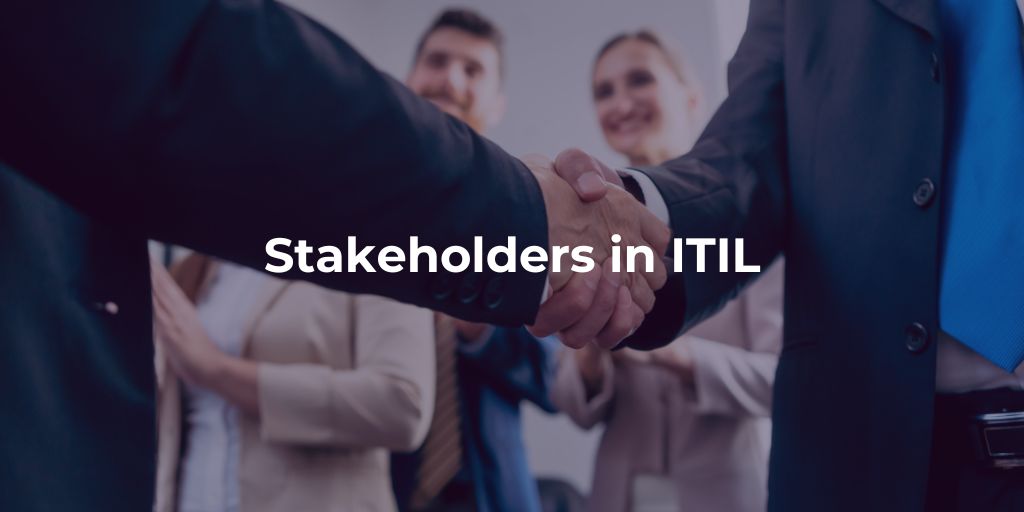IT services deal with stakeholders throughout the ITSM (IT service management) and in almost every process of the organisation. Stakeholders are the human component of the service i.e. all those that have interest in IT services. Stakeholders also include users and customers.
Even though often taken for granted, stakeholders are vital to achieving the organisation’s objectives. Without stakeholders, an IT service does not exist. They are the ones who carry out the main processes and who provide the resources to ensure business continuity. Stakeholders are key for ITSM and, consequently, for ITIL.
Internal and External Stakeholders
Stakeholders can be divided into two main groups, internal and external.
- Internal stakeholders
- Those that work within the same organisation (think of the employees of the ITSM organisation, the team, management, partners etc.).
- Internal IT providers can also be internal customers.
- External stakeholders
- Those that are not part of the organisation. These stakeholders can be external customers and users, suppliers and vendors.
Within ITIL there are many different stakeholders that can be identified. The four major stakeholders, without whom IT service management cannot survive, are the following:
- Service provider: an entity that provides IT services such as internet, email, specific tools and network maintenance.
- Customer: someone that pays for the service, both internal and external. As the customer pays for the service, they put in their demands and agree on service levels.
- End user: somebody that uses the service. This person might not be the one paying for the service, but is entitled to use it.
- Supplier: another organisation that provides services and/or products. For example hardware and/or software suppliers that are the basis of the provided IT service.
Stakeholder Relevance
By being clear as to who the stakeholders of your IT service are, you are able to define the supporting organisation, processes and interfaces. Stakeholders are basically (directly and indirectly) responsible for the delivery of the services.
If you understand who your stakeholders are, what their interests are and how they are/will be using your services, you can understand their demands towards your services. Once you do so, you will be able to respond with appropriate capacity and adapt to the different stages of the IT service lifecycle.
Some vital functions that stakeholders perform are:
- Continuous Improvement: through constant monitoring and evaluation of processes, stakeholders will guarantee the continuous improvement of the service.
- Objectives and Strategies: both small and large, immediate and long term objectives and strategies are based on the needs of all the different stakeholders involved.
- Implementation and Delivery: the implementation of processes and tasks, but also the service delivery, will depend on the efficient work of stakeholders.
Drive Stakeholder Value
However important the stakeholder might be, often organisations do not give them the attention they need. Organisations tend to focus on certain factors like efficient processes and appropriate technology.
To reverse this thought and focus on the human component of IT services, Axelos launched the ITIL Drive Stakeholder Value module. The module helps ITIL practitioners to increase stakeholder satisfaction.
The ITIL DSV module is part of the ITIL 4 Managing Professional stream. The module is about engagement and interaction between service providers and stakeholders, including the conversion of demand to value via IT-enabled services.
The module is built around the customer journey, focusing on both parties working together and interacting to co-create value. It encourages the service provider to help the consumer to continually improve.
Key elements of Driving Stakeholder Value
Changing the scope and approach of the traditional IT expert, the DSV module helps create awareness about how the interaction between provider and stakeholder will influence their ultimate experience and therefore the organisation’s success.
The capabilities that must be developed are:
- Ensuring high satisfaction levels: When consuming a service, the experience should be just as important as the outcome
- Using human-centred design: Achieve better usability and experience by understanding how the customer feels when using a service
- Customer Experience (EX) and User Experience (UX) design: Achieving quality outcomes based on experience agreements
- Stakeholder communication: Listening and understanding what each party wants and needs, understanding the dynamics and co-create value
QRP International is an ATO (Authorised Training Organisation) for ITIL Drive Stakeholder Value courses, both virtual and on-site. If you are interested in learning more, check our website or contact us!








